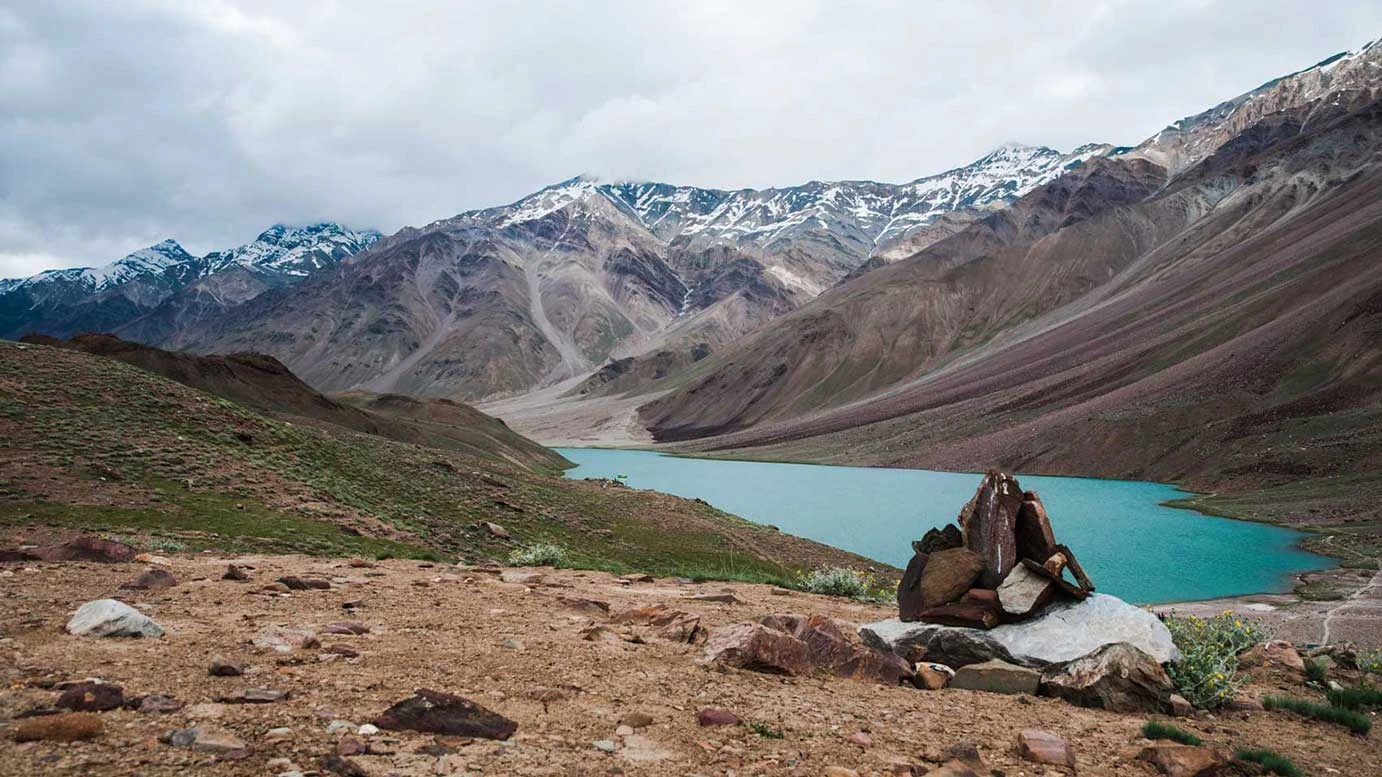Embark on a mesmerising journey to Chandratal Lake and Spiti Valley, one of the most enchanting destinations in Himachal Pradesh. Known as the “Moon Lake” due to its crescent shape, Chandratal Lake sits at an altitude of 4,300 meters, surrounded by snow-capped peaks and rugged Himalayan landscapes. This pristine high-altitude lake reflects a brilliant turquoise colour in the sunlight, creating a picture-perfect setting for nature lovers and photographers.
The trip to Spiti Valley offers an adventurous escape into the remote landscapes of the Trans-Himalayas. From quaint villages like Kaza and Kibber to monasteries such as Key Monastery, the valley combines natural beauty, culture, and spirituality. Travellers can witness the stark, barren beauty of the cold desert, high-altitude trekking trails, and the local Himalayan lifestyle.
A Chandratal Lake trip with the Spiti Valley is perfect for adventure seekers and peace lovers alike. Whether you are camping under the stars by the lake, trekking across rugged terrains, or exploring charming villages, the experience promises breathtaking views and unforgettable memories.
Best Time to Visit: June to September – when roads are accessible and the lake is thawed, offering clear, mesmerising reflections.
Activities: Camping at Chandratal, high-altitude trekking, photography, nature walks, exploring monasteries, and experiencing local culture.
Travel Tips: Carry warm clothes, high-energy snacks, and sun protection. Acclimatise properly to avoid altitude sickness.
Experience the magic of the Spiti Valley and the serene beauty of Chandratal Lake on a trip that blends adventure, nature, and tranquillity.
The Chandratal Lake trek is a breathtaking journey to one of Himachal Pradesh’s most stunning high-altitude lakes, situated at an elevation of 4,250 meters in the Lahaul and Spiti region. Renowned as the 'Moon Lake' due to its distinctive crescent shape, Chandratal offers crystal-clear waters surrounded by rugged mountains and alpine meadows. The trek usually begins from Batal or Kunzum Pass and takes you through dramatic landscapes and glacial streams. Ideal from late June to early October, the Chandratal Lake trek is perfect for adventure lovers and nature enthusiasts. Camping under starry skies makes the Chandratal Lake trek a truly unforgettable Himalayan experience.
Key Monastery, also known as Kye or Ki, is perched on a hilltop at an elevation of 4,166 meters. The monastery commands breathtaking views, making it the largest and most prominent monastery in the Spiti Valley. Overlooking the serene Spiti River in Himachal Pradesh’s Lahaul and Spiti district, it belongs to the Gelugpa (Yellow Hat) tradition of Tibetan Buddhism. This historic monastery serves as both a spiritual centre and a learning institute for young lamas. Inside, visitors can explore ancient murals, sacred texts, and finely crafted Buddha statues. The lower level features a beautifully decorated Assembly Hall and simple living quarters for monks. With its fortress-like design and deep-rooted spiritual essence, Key Monastery stands as a powerful testament to Buddhist faith and endurance amidst the rugged Himalayan terrain.
A favourite among motorbiking adventurers, Kunzum Pass (Kunzum La) serves as a dramatic entrance into the Lahaul and Spiti Valleys of Himachal Pradesh. Standing at one of the highest motorable altitudes in India, this mountain pass offers a thrilling and scenic ride that attracts bikers from across the country. It is not just a route, but an experience; riders often stop to circumambulate the temple of the Goddess Durga, a tradition believed to ensure a safe passage. Many also use Kunzum Pass as a gateway to the enchanting Chandratal Lake, making it a must-stop for spiritual seekers and adventure lovers alike.
Tucked away in the stark, high-altitude terrain of Spiti Valley in Himachal Pradesh’s Lahaul and Spiti district, Pin Valley National Park is among India’s loftiest wildlife sanctuaries. Surrounded by rugged mountains and fed by the pristine Pin River, this cold desert sanctuary is a haven for rare Himalayan wildlife and hardy alpine flora, making it a must-visit for nature lovers and solitude seekers.. Named after the beautiful Pin River, this protected area lies within the stark and dramatic landscapes of the Spiti region. Established to conserve the rare and fragile ecosystem of this high-altitude desert, the park is Home to rare flora and fauna adapted to harsh, extreme conditions. It also serves as a natural link between the Lahaul and Spiti valleys, offering a blend of breathtaking scenery, biodiversity, and solitude. The park’s isolation makes it a hidden gem for nature enthusiasts, trekkers, and wildlife lovers alike.
Dhankar Gompa (also spelt Dankhar, Drangkhar, or Dhangkar) is both a Buddhist monastery and a traditional village perched dramatically on a cliffside in the Lahaul and Spiti district of Himachal Pradesh. Strategically located between Kaza and Tabo, this ancient monastery overlooks the confluence of the Spiti and Pin rivers, offering breathtaking panoramic views of the valley below. Built at a high altitude, Dhankar served as a fort-monastery in ancient times and is a significant spiritual site on any Spiti Valley expedition. Its unique setting and historical importance make it a must-visit for travellers exploring the region.
Located in the tranquil village of Tabo, Tabo Monastery in Spiti Valley, stands as one of the oldest continuously operating Buddhist monasteries in the Himalayas. Established in 996 AD, it is often referred to as the "Ajanta of the Himalayas" for its ancient murals, scriptures, and intricate stucco art. Built with thick earthen walls, the complex has endured centuries of harsh weather. At dawn, lamas gather for prayers in the newer temple buildings, keeping alive age-old traditions. The monastery is also the heart of several vibrant festivals celebrated throughout the year, making it a spiritual and cultural gem that’s essential on any journey through Spiti.
Dhankar Lake lies tucked away in the heart of the Spiti Valley, offering a serene and unforgettable escape for travellers. Set above the ancient Dhankar Monastery, this high-altitude lake is known for its tranquil beauty and surreal landscapes. The crystal-clear blue waters shimmer under the sun, creating a picture-perfect reflection of the surrounding mountains. Reaching the lake involves a short hike, but the views and peaceful atmosphere make it well worth the effort. A visit here is not just scenic, it's soulful, and the memory of this hidden gem will stay with you for a lifetime. Nature has truly blessed this remote corner of the Himalayas.
Nestled high in the Spiti Valley, Kibber, also known as Kibber Khas or Khyipur, is one of the highest inhabited villages in the world, reachable by motorable roads. This time-worn village is home to an ancient monastery. It serves as the gateway to the renowned Kibber Wildlife Sanctuary, a protected area recognised for its elusive snow leopards and other rare Himalayan fauna. Historically, Kibber was a vital point on the old trade routes connecting Tibet, Ladakh, Chamba, and Kullu, where merchants bartered goods and shared cultures. During the short summer season, Kibber’s farmers cultivate crops suited to the region’s alpine climate, creating a unique blend of survival and self-sufficiency amidst the dramatic Himalayan landscapes.
The Kaza market is the shopping hub of Spiti Valley, offering a variety of Tibetan and Buddhist handicrafts. Popular items include:
Prayer flags, bowls, and wheels
Buddha statues and Thangka paintings
Locally made woollens and Spiti-themed t-shirts
Traditional woodwork, semi-precious stones, and jewellery
These handmade treasures beautifully reflect Spiti’s deep-rooted spiritual traditions and rich cultural heritage. Be prepared to be surprised by the diversity of local craftsmanship available in this high-altitude desert.
Located near Keylong in the Bhaga Valley, Tayul Monastery (also known as Tayul Gompa) is one of the oldest Buddhist monasteries in northern India, situated at an elevation of 3,900 meters. This peaceful retreat is reached via a steep trail from Satingri village and offers spectacular mountain views.
The monastery houses an impressive library with 101 Buddhist scriptures (Kangyur) and colourful Thangka paintings that illustrate the life of the Buddha. Tayul is a hidden gem for those seeking spiritual solitude and timeless Himalayan art.
The village of Gue, near the Indo-Tibetan border, holds one of Spiti’s most intriguing secrets, a 500-year-old naturally preserved mummy of the Buddhist monk Sangha Tenzin, seated in a meditative pose with skin and hair still intact.
Located 40 km from Tabo Monastery, this remarkable relic draws curious travellers and spiritual seekers alike. While currently controlled by India, the region lies close to contested borders and offers a unique cultural and historical experience rarely seen elsewhere in the world.
Nestled in the serene landscapes of Pin Valley, Kungri Monastery stands as the second-oldest monastery in Spiti. It holds the unique distinction of being the region’s only monastery affiliated with the Nyingma tradition of Tibetan Buddhism. Built around 1330 AD, the monastery complex comprises three east-facing blocks, and its remote setting exudes peace and spiritual energy. A visit to Kungri offers a glimpse into ancient Buddhist traditions, rarely found in such authentic settings elsewhere.
Spiti Valley, particularly the Kaza marketplace, is dotted with Tibetan-run shops offering a wide range of cultural souvenirs:
Tibetan jewellery and semi-precious stones
Local woollen garments and woven shawls
Intricately carved wooden items and paintings
Ceramic utensils, singing bowls, and prayer wheels
These items reflect the deep Buddhist roots and centuries-old Himalayan craftsmanship that have been passed down through generations. Shopping here not only supports the local community but also allows travellers to carry a piece of Spiti’s soul back home.
Activities To Do In Spiti Valley
Camping in Spiti & Kinnaur
For those who love the outdoors, camping in Spiti Valley or Kinnaur offers a raw, immersive experience in nature. There are numerous scenic spots across both regions where you can pitch a tent under the starry sky. Not only does camping bring you closer to the landscape, but it also allows you to save on accommodation costs while experiencing the serene remoteness of the Himalayas.
Homestays in Spiti and Kinnaur offer travellers a warm, authentic, and affordable stay unlike traditional hotels. Staying with a local family allows you to experience the region’s culture firsthand, from home-cooked meals to daily traditions. It’s more than just a place to stay; it’s an opportunity to connect with locals and experience the culture from within. Whether you're a solo traveller or with a group, homestays offer comfort, community, and a sense of belonging in an otherwise remote destination.
Hidden above the ancient Dhankar Monastery lies the peaceful Dhankar Lake, a pristine high-altitude body of water set against rugged backdrops. The short yet rewarding trek to the lake is an ideal destination for those who love nature and cherish solitude. With crisp mountain air, panoramic views, and the tranquil sound of the wind brushing past, this serene spot offers a soul-refreshing experience far removed from urban life.
Spiti Valley is one of the best stargazing destinations in India, thanks to its high altitude, clear skies, and minimal light pollution. Villages such as Komic, Kibber, Dhankar, Tabo, and Losar provide stunning night skies, offering clear provides breathtaking sights of the Milky Way and innumerable constellations, making them perfect spots for stargazing Whether you're with a telescope or just lying back on a sleeping bag, gazing at the infinite Himalayan night sky is an unforgettable experience, especially when shared with someone special.
Fossil Hunting in Langza & Hikkim
Spiti Valley was once part of the Tethys Sea, and today, fossil hunting around Langza and Hikkim offers a fascinating glimpse into that prehistoric past. It’s a rare and exciting adventure, especially for history buffs and geology enthusiasts. While the activity isn’t overly commercialised yet, chances of spotting ammonite and marine fossil imprints are high and deeply rewarding.
Among the most unique experiences in Spiti is a yak safari. These gentle giants are integral to local life, providing transportation and dairy to remote villages. Riding a yak through the rugged mountain terrain, past monasteries and glacial rivers, is a slow, meditative journey through one of India’s most remote landscapes. It’s both culturally authentic and unforgettable.
Explore the World’s Highest Post Office – Hikkim
Situated at a staggering altitude of 14,567 feet, Hikkim is home to the world's highest post office, an iconic destination where travellers can send postcards from the top of the world. Sending a postcard from here is more than just a novelty; it’s a chance to share a piece of your Himalayan journey with loved ones back home. Designed to resemble an oversized red letterbox, the post office has become an iconic landmark for travellers, a charming symbol of Spiti’s remote beauty and high-altitude uniqueness.






